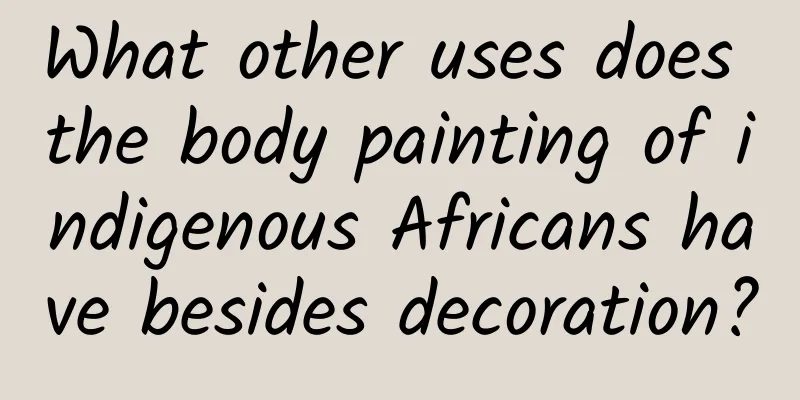What other uses does the body painting of indigenous Africans have besides decoration?

|
In some primitive tribes in Africa, Australia, Papua New Guinea and North America, many tribesmen often paint their bodies with white, bright yellow or beige stripes. These painted patterns are extremely diverse. They are generally used as body decorations for tribal members. Some are used to express emotions or as marks of personal identity. What’s even more interesting is that these painted stripes are very similar to the stripe patterns of animals such as zebras and okapis. Perhaps historically and culturally, their ancestors liked this type of stripes, but studies have shown that these striped patterns actually serve as camouflage and protection against horsefly bites. In the areas where these primitive tribes live, horseflies are extremely annoying creatures that suck the blood of livestock such as cattle and sheep. This will not only cause trouble to the cattle, but also have a significant impact on the local indigenous people. Because horseflies are not picky eaters, they often land on exposed areas of the human body to suck blood. In the intervals between sucking blood, they may also leave parasites or insect eggs on the human body surface. However, zebras living next to these indigenous people are rarely favored by horseflies, because studies have shown that the black and white stripes of zebras can effectively reduce bites from blood-sucking insects such as horseflies. It seems that the striped paintings applied by the local indigenous people have the same function as zebra stripes. So why can these stripes prevent horseflies from landing on the surface of the host organism's body? In fact, by comparing stripes and no stripes, it can be seen that the stripes can visually protect the host from the attack of blood-sucking horse flies. Because horseflies use the polarization of reflected light to find the presence of hosts and water sources , reflected light with vertical polarization will only attract females seeking host blood; while reflected light with horizontal polarization will attract both females and males seeking water sources. To this end, researchers conducted two sets of experiments in the wild in Hungary. The researchers painted the human model with black and white stripes. As a control, they also set up a beige model and a brown model, and coated the models with colorless capture glue to collect horseflies that landed on the models. In the first set of experiments, the researchers hypothesized that a standing human model would reflect primarily vertically polarized light and thus might attract female horseflies seeking blood. In the second set of experiments, it was assumed that the human body model in a lying position mainly reflected horizontally polarized light to simulate the reflection polarization characteristics of the water surface. After the experiment was set up, the researchers placed the model in the wild, collected horseflies on the surface of the model every two days, cleaned up other insects, and then moved the model to a new location. The results of nearly ten days of experiments showed that the brown human body model reflected the highest degree of polarization (d<90%), the beige one was in the middle (d<20%), and the black and white striped human body model had almost no polarization (d<5%). Proportional to the experimental results, the number of horseflies collected was the largest on the brown human model, followed by the beige one, and the least on the striped human model. This suggests that striped body paint may indeed protect against horsefly bites by making the body less visually attractive to flies. In addition to horseflies, researchers also conducted experiments on gadflies in Africa, Australia and other regions and found that striped painting is also effective. Therefore, the experiment concluded that striped painting can reduce the attacks of most blood-sucking insects (such as horseflies, gadflies, etc.), thereby reducing the chances of being bitten and spreading diseases. |
<<: Success! my country has made a new breakthrough! It will benefit the world!
>>: Something big happened today!
Recommend
Official account: Niantian Jue Xue Niantian Jue Ji (Part 3) Fault series video
Official account: Nian Tian Jue Xue Nian Tian Jue...
How to write a promotional copy that goes viral with product thinking
When we see a good product review article, we oft...
Douyin operation and promotion: How to use hot products to improve retention?
In order to provide more dimensions of thinking, ...
Feishu-9 Lectures on Digital Tools for Organizations: Advanced Tools Make Organizations More Advanced
Feishu-9 Lectures on Digital Tools for Organizati...
What should we expect from WMC?
[[128358]] The GSM Association is one of the thre...
Madhouse "TIKTOK SHOP Small Store Practical Training Camp" Overseas small stores bring goods, master TK small store operations from 0 to 1
Course Content Catalog: TikTokShopi Training Camp ...
The promotion has no effect and there are malicious clicks. How to solve it?
Recently I heard a lot of people talking about pr...
The lifeline for the transformation of traditional industries is not the Internet, but finance!
[[157015]] Under the policy of "mass entrepr...
Watching a suspense drama actually made me ravenous! There are so many delicacies in "The Long Season"...
During the recent May Day holiday, the shoes of &...
Saved it! A complete collection of commonly used auxiliary tools for APP promotion!
Some people say that App promotion is hard work. ...
A map tells you where to see the most beautiful volcanic lake in China
Loading long image... Source: National Geographic...
What to do if an elderly person falls? Millimeter-wave radar can help you solve the problem
Statistics show that about 40 million elderly peo...
Master these 4 creative techniques for information flow advertising and increase your click-through rate by over 30%!
Nowadays, information flow advertising has become...
After checking in at so many "Shuizhai Miao" bubbles, even the "mud" is so beautiful!
Songyuan City, also known as "Bodune, New Ci...
It is said that product and marketing experts all "understand human nature". How can you do that?
After working in the product and marketing fields...









